Indoor Sport Services Training Guide
Our Indoor Rowing Training Guide is the ultimate training resource for the Indoor Rower. Written by top education and coaching specialists, it includes information on technique and training, with programmes on cross-training, 2,000m and marathon race training, weight management and keep fit. There are guest chapters written by top names such as Jurgen Grobler and Chris Shambrook as well as dedicated sections on psychology, nutrition and weight training.
Technique on the Indoor Rower - Technical Faults and Solutions
<< Technique IllustratedThe Need For Exercise >>Correct technique is essential for efficient rowing and to reduce the risk of injury. Here are some of the most common errors, with the reasons they are inefficient, and solutions to help you prevent or correct any problems.
Rowing with bent armsWhen the arm supports a load in one position the muscle remains contracted. Contraction expels blood from the muscles reducing the oxygen supply, increasing lactic acid build up and hastening fatigue. |
|
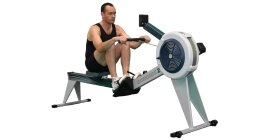 |
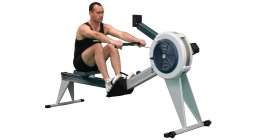 |
FaultThe rower starts the Drive by pulling with the arms rather than pushing with the legs. |
CorrectionThe Drive should start by pushing the legs and bracing the back with the arms fully extended and relaxed. The arms connect the legs and the back onto the handle. |
Pulling up too high and rowing with bent wristsWork can be carried out more efficiently and the risk of injury reduced when the load passes through the centre of joints. |
|
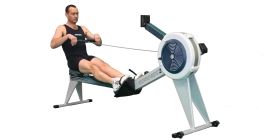 |
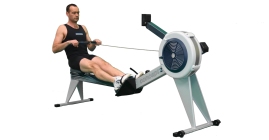 |
FaultRowing at various stages of the stroke with bent wrists. |
CorrectionAlways row with FLAT wrists. Check the hands at each stage of the Drive. |
Pulling up too far and leaning back too muchLeaning back too far requires a great deal of energy to swing the body back through the upright position. The energy costs are greater than any gains through rowing a longer stroke. |
|
 |
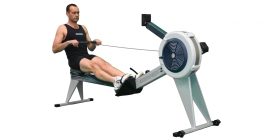 |
FaultAt the Finish of the stroke, the rower pulls the handle up too high and leans back too far. |
CorrectionDraw the handle into the body. The wrists should be flat with elbows drawn past the body, forearms horizontal. |
Slide shootingThe legs are the most powerful muscles in the body and are used to start the acceleration of the flywheel, which represents the greatest load. Any movement of the seat should result in a corresponding movement of the handle or the legs are not being used to the greatest effect. |
|
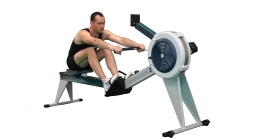 |
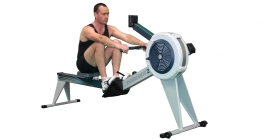 |
FaultThe legs push away too early, the back is not braced and so the power is not transferred onto the handle. |
CorrectionThe legs begin the drive and the body moves back with straight arms transferring the leg power onto the handle. |
Using the back too earlyUsing the back too early means that the weaker muscles are taking on the greater load and the stronger muscles are used when the load has decreased. |
|
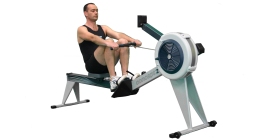 |
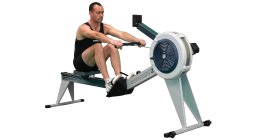 |
FaultThe rower starts the Drive by swinging the body back rather than pushing the legs. This results in a weak movement. |
CorrectionThe legs begin the drive and the body levers back with the arms fully extended and relaxed. |
Knees up too earlyAt the beginning of the stroke you need to be balanced and in control in order to develop maximum power. If the recovery sequence of hands, body then slide is not carried out correctly then this will mean a last minute adjustment at the beginning of the power phase, throwing you off balance and out of control. |
|
 |
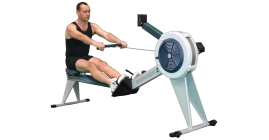 |
FaultOn the Recovery the rower slides forward before the handle has extended past the knees. The hands either hit the knees or they are lifted up to clear the knees. |
CorrectionThe Recovery sequence - hands, body, then slide. AFTER the arms have fully extended and the body has rocked forward, slide forward, maintaining the arm and body position. |
Over reachingOver reaching at the beginning of the stroke places the lower back at maximum flexion. If you then load it up there is a risk of tissue damage in this area. |
|
 |
 |
FaultThe body stretches too far forward. The shins may be past the vertical. The head and shoulders tend to drop towards the feet. The body is in a weak position for the Drive. |
CorrectionThe shins are vertical. The body is pressed up to the legs. The arms are fully extended and relaxed, body tilted slightly forward. This position should feel comfortable. |
Body too tense. Grip on handle too tightThe only muscles that should be contracted are those directly involved in moving the flywheel. Any muscles in the shoulders and neck that are not directly involved will just drain energy if tensed. |
|
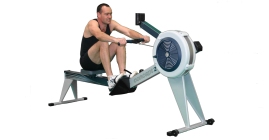 |
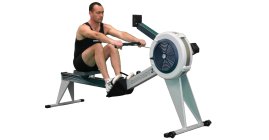 |
Faulteeth are clenched, shoulders hunched and the rower is gripping the handle too tightly. |
CorrectionRELAX! Relax the shoulders down, unclench the teeth and relax the jaw. Keep a LIGHT hold on the handle. |
Pulling the body to the handleIf you pull the body towards the handle there is an energy cost but it will not add anything towards moving the flywheel. |
|
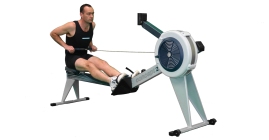 |
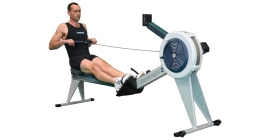 |
FaultAt the Finish, the rower, instead of pulling the handle to the body, pulls himself forward to the handle. |
CorrectionAt the Finish the rower leans back slightly, holds the legs down and draws the handle to the body using the upper body as a firm platform. |
Flying elbows |
|
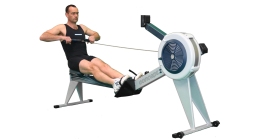 |
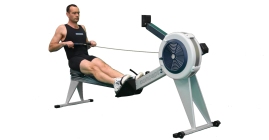 |
FaultThe rower's elbows are sticking out from the body at the finish. |
CorrectionDraw the handle to the body. The wrists are flat and the elbows drawn past the body. |

